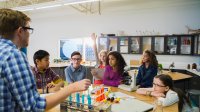Guiding Students to Ask Questions and Define Problems in Science
Teachers can use these strategies to help students in grades 6 to 12 develop skills that are crucial to scientific study and exploration.
Without clear questions and well-defined problems, scientific investigations lack direction and focus, leading to inconclusive or irrelevant results. That’s why the first science and engineering practice is asking questions and defining problems. This is the foundation upon which scientific inquiry and problem-solving are built.
More important, asking questions and defining problems are essential skills in life that enable individuals to think critically, solve problems, and make informed decisions.
As STEAM professional development specialists, we’re fortunate to work with hundreds of teachers and students in the collective subjects of STEAM. We’ve identified several reasons why students have a hard time asking questions and defining problems.
We’ve witnessed a lack of confidence, limited prior exposure, fixed mindsets, overemphasis on answers, fear of judgment, and students not seeing the relevance to their lives.
supporting students in Developing These Skills
Teachers of grades six through 12 play a crucial role in helping students develop their ability to ask questions and define problems in science. To begin, we employ the 5E Model of Instruction (engage, explore, explain, elaborate, evaluate) with our teachers.
In this student-centered model, instruction begins with students asking questions and exploring phenomena rather than teachers delivering content or information. Even if teachers don’t employ the 5E Model, we work with them on practical applications to have students ask and explore before the teachers explain.
We’ve identified four overarching ideas that teachers can start working on tomorrow with their students.
- Encourage curiosity: Create an environment that encourages curiosity by simply presenting phenomena connected to the curriculum and standards and then allowing students to ask questions related to the phenomena. The Wonder of Science has science phenomena aligned to all grades and disciplinary core ideas.
- Offer opportunities for inquiry: Provide opportunities for students to engage in inquiry-based learning, which encourages them to ask their own questions, investigate topics of interest, and define their own problems. This can help students take ownership of their learning and develop skills in problem-solving, research, and analysis.
- Provide scaffolding: Offer guidance and support as students engage in questioning and problem-definition activities. Model effective questioning techniques, provide resources for research, and offer feedback on student-generated questions and problem statements. This helps create a safe and inclusive classroom environment where students feel comfortable and are capable of expressing their ideas and opinions.
- Use real-world examples: Help students connect their questions and problem statements to real-world contexts that are relevant and meaningful to their lives. Teachers can use case studies and encourage students to identify issues in their local community, current events, or global challenges so that they see the relevance and applicability of their learning. This can help students develop a broader perspective and understand how their learning is relevant and applicable in the real world, preparing them for future challenges and opportunities.
In addition to the four overarching ideas, we’ve put together four practical techniques and routines to support our colleagues and students. The links below can show how to specifically employ the techniques and routines in the classroom. Although our perspective is STEAM, the routines and techniques can be used in a variety of settings.
- Question Formulation Technique: QFT is a structured approach to asking questions. It improves communication skills, critical thinking, and problem-solving skills as well as metacognition. It also increases student autonomy and ownership of learning.
- Need to Know Questions: These questions are used to guide students’ inquiry and drive their learning. “Need to know” questions help students engage in critical thinking and inquiry, while also providing a framework for their learning and guiding their research and investigation. Students can take ownership of their learning and develop a deeper understanding of the topic or issue at hand.
- See, Think, Wonder: This routine is designed to encourage students to engage with visual stimuli. By using “see, think, wonder,” students develop their observation and interpretation skills, ask refined questions, and learn how to approach visual stimuli with a critical and curious mindset. Ultimately, it promotes inquiry, creativity, and critical thinking.
- Design Thinking Bootleg: This is a set of tools to support the design thinking process. The approach promotes asking questions and defining problems through its iterative and human-centered process, which involves several stages that encourage inquiry and problem definition. By using design thinking, students develop critical thinking skills, empathize and connect to the perspectives of others, enhance their communication skills, and reflect and employ metacognition.
The ability to ask questions and define problems is a critical skill in the field of science. Whether working in a laboratory, conducting field research, or simply trying to understand the world around us, asking questions and defining problems are the first steps toward knowledge and discovery, and they’re essential skills in many other aspects of life as well.
